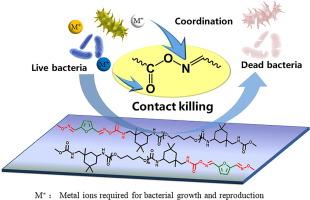Synthesis and evaluation of bio-based Poly(oxime-urethane) with intrinsic antimicrobial properties
IF 5.8
2区 化学
Q1 POLYMER SCIENCE
引用次数: 0
Abstract
Intrinsic antimicrobial properties can give polyurethanes a wider range of applications. In this work, the bio-based chain extender, 2,5-diformylfuran dioxime (DFFD) possessing antimicrobial characteristic, is used to synthesize the intrinsical antimicrobial poly(oxime-urethane) (Dx-PU) with isophorone diisocyanate (IPDI) and poly(tetramethylene glycol) (PTMG-1000), and its properties are investigated. The results show that the tensile strength is 19.12 ± 0.49 MPa, the Young’s modulus of the poly(oxime-urethane) is 118.70 ± 11.40 MPa. The elongation at break and Shore A hardness were 292 ± 11 % and 93 ± 2, respectively. Additionally, the Dx-PU demonstrated a high thermal decomposition temperature of over 250 °C and a low glass transition temperature of the soft segments at approximately −60 °C. Meanwhile, research on Dx-PU coating has demonstrated that Dx-PU coating is 100 % antimicrobial against E. coli and S. aureus, and is suitable for use on a wide range of substrates, including glass, engineering plastics, metal and leather with excellent adhesion (ISO 0), pencil hardness (2H), impact resistance (0.5 m·kg) and flexibility (2 mm). The Dx-PU coating also has significant antibacterial performance in everyday environments. The outstanding flexibility, moderate Young’s modulus, high elongation at break, good thermal resistance, and excellent antimicrobial performance of Dx-PU make it highly suitable for applications on high-contact surfaces such as hospital walls, public sanitation facilities, countertops, and door handles. As a bio-based chain extender from renewable sources, DFFD offers new solutions for the synthesis of bio-based antimicrobial polyurethane and its coatings.

具有内在抗菌特性的生物基聚(肟-聚氨酯)的合成与评估
内在抗菌特性可为聚氨酯带来更广泛的应用。本研究利用具有抗菌特性的生物基扩链剂 2,5-二甲酰基呋喃二恶肟(DFFD)与异佛尔酮二异氰酸酯(IPDI)和聚四甘醇(PTMG-1000)合成了本征抗菌聚氨酯(Dx-PU),并对其性能进行了研究。结果表明,拉伸强度为 19.12 ± 0.49 兆帕,杨氏模量为 118.70 ± 11.40 兆帕。断裂伸长率和邵氏硬度分别为 292 ± 11 % 和 93 ± 2。此外,Dx-PU 的热分解温度高达 250 ℃ 以上,软段的玻璃化转变温度较低,约为 -60 ℃。同时,对 Dx-PU 涂层的研究表明,Dx-PU 涂层对大肠杆菌和金黄色葡萄球菌具有 100% 的抗菌性,并适用于多种基材,包括玻璃、工程塑料、金属和皮革,具有出色的附着力(ISO 0)、铅笔硬度(2H)、抗冲击性(0.5 m-kg)和柔韧性(2 mm)。在日常环境中,Dx-PU 涂层还具有显著的抗菌性能。Dx-PU 具有出色的柔韧性、适中的杨氏模量、较高的断裂伸长率、良好的耐热性和优异的抗菌性能,因此非常适合应用于医院墙壁、公共卫生设施、台面和门把手等高接触表面。作为一种来自可再生资源的生物基扩链剂,DFFD 为合成生物基抗菌聚氨酯及其涂层提供了新的解决方案。
本文章由计算机程序翻译,如有差异,请以英文原文为准。
求助全文
约1分钟内获得全文
求助全文
来源期刊

European Polymer Journal
化学-高分子科学
CiteScore
9.90
自引率
10.00%
发文量
691
审稿时长
23 days
期刊介绍:
European Polymer Journal is dedicated to publishing work on fundamental and applied polymer chemistry and macromolecular materials. The journal covers all aspects of polymer synthesis, including polymerization mechanisms and chemical functional transformations, with a focus on novel polymers and the relationships between molecular structure and polymer properties. In addition, we welcome submissions on bio-based or renewable polymers, stimuli-responsive systems and polymer bio-hybrids. European Polymer Journal also publishes research on the biomedical application of polymers, including drug delivery and regenerative medicine. The main scope is covered but not limited to the following core research areas:
Polymer synthesis and functionalization
• Novel synthetic routes for polymerization, functional modification, controlled/living polymerization and precision polymers.
Stimuli-responsive polymers
• Including shape memory and self-healing polymers.
Supramolecular polymers and self-assembly
• Molecular recognition and higher order polymer structures.
Renewable and sustainable polymers
• Bio-based, biodegradable and anti-microbial polymers and polymeric bio-nanocomposites.
Polymers at interfaces and surfaces
• Chemistry and engineering of surfaces with biological relevance, including patterning, antifouling polymers and polymers for membrane applications.
Biomedical applications and nanomedicine
• Polymers for regenerative medicine, drug delivery molecular release and gene therapy
The scope of European Polymer Journal no longer includes Polymer Physics.
文献相关原料
公司名称
产品信息
麦克林
Isophorone diisocyanate (IPDI)
麦克林
tetrahydrofuran (THF)
阿拉丁
4A molecular sieves
 求助内容:
求助内容: 应助结果提醒方式:
应助结果提醒方式:


